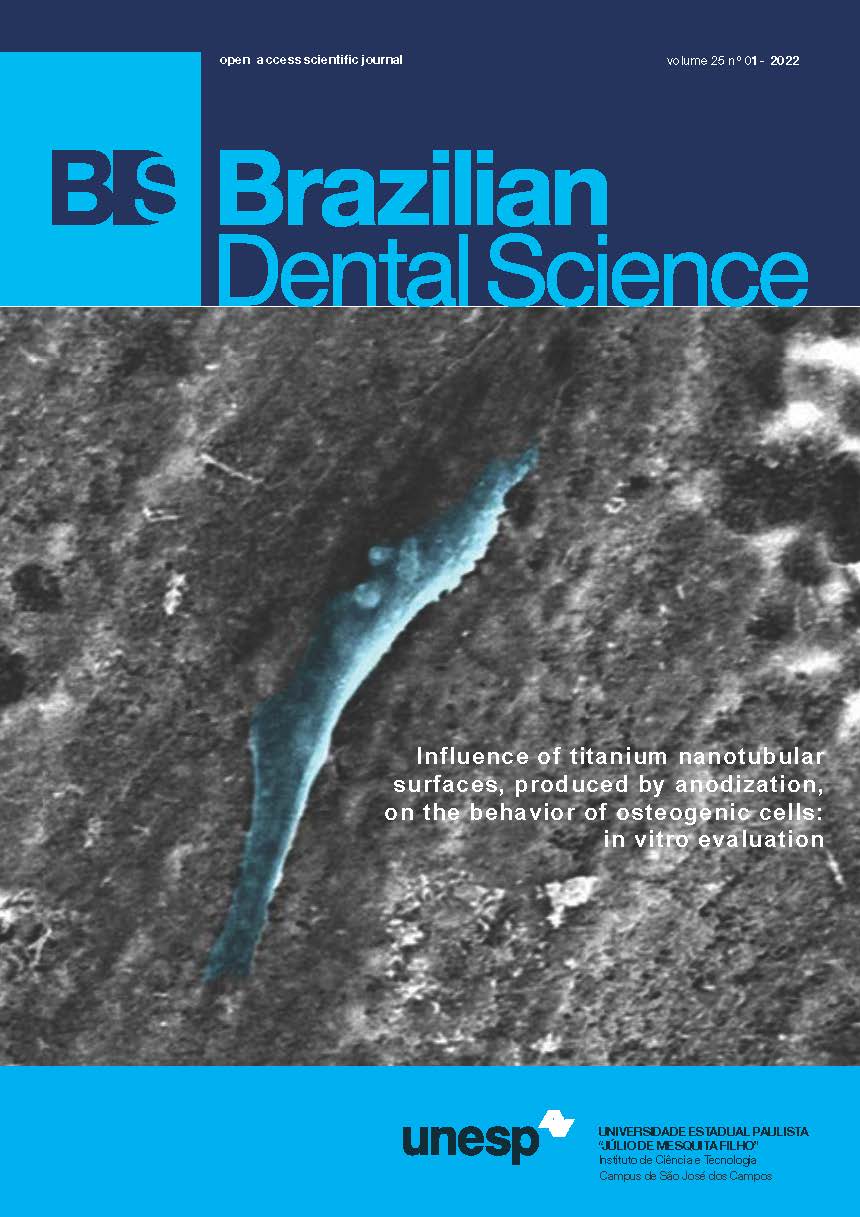Effect of whitening mouthrinses on color change of stained resin composites
DOI:
https://doi.org/10.4322/bds.2022.e2773Resumen
Objective: The present study compared the effect of whitening mouthrinses (WM) on the color change of stained
resin composites (RC). Material and Methods: Cylindrical specimens (6mm-diameter and 1mm-thickness)
were prepared with the following RC (n=60/group): Filtek Z350XT (Z350- methacrylate-based), Admira Fusion
(AD- ormocer-based), TPH3 (TPH- methacrylate-based), and Beautifil II (BII- giomer/methacrylate-based).
The initial color was assessed with reflectance spectrophotometer using CIE L*a*b* system. The specimens
were immersed in staining broth during 14 days, submitted to color evaluation (E1) and randomly allocated
in 4 subgroups (n=15), according to WM adopted: Listerine Whitening (LW-2% hydrogen peroxide), Plax
Whitening (PW-1.5% hydrogen peroxide), Bromelain/papain (BP-experimental solution), and Deionized water
(DW-negative control). The whitening cycle consisted of RC immersion in WM for 1 min and in artificial saliva
for 30 min, simulating 12 weeks, and final color assessment was performed (E2). Color change data were
analysed by ANOVA and Tukey’s tests (a=5%). Results: After staining, TPH showed the lowest E1 values
and Z350 showed the highest color change (p=0.001). The whitening effect promoted by LW was significantly
higher than color alteration obtained with PW (E2), and BII showed the highest color change values (E2) after
whitening cycle. Conclusion: LW exhibited the greatest whitening potential on stained RC, mainly with the
Giomer (Beautifill II) and the Ormocer-based (Admira Fusion) materials. Bromelain/papain solution showed
no whitening effect on stained RC.
KEYWORDS
Giomer; Hydrogen peroxide; Ormocer; Resin composite; Whitening mouthrinses.
Descargas
Descargas
Publicado
Versiones
- 2022-03-29 (2)
- 2022-02-04 (1)
Cómo citar
Número
Sección
Licencia
Brazilian Dental Science uses the Creative Commons (CC-BY 4.0) license, thus preserving the integrity of articles in an open access environment. The journal allows the author to retain publishing rights without restrictions.
=================
COPYRIGHT TRANSFER AND RESPONSIBILITY STATEMENT
(PDF)
For all articles published in the BDS journal, copyright is retained by the authors. Articles are licensed under an open-access Creative Commons CC BY 4.0 license, meaning that anyone may download and read the paper for free. In addition, the article may be reused and quoted, provided that the original published version is cited. These conditions allow for maximum use and exposure of the work while ensuring that the authors receive proper credit. All metadata associated with published articles is released under the Creative Commons CC0 Universal Public Domain Dedication.
Before the submission, authors must obtain permission to reproduce any published material (figures, schemes, tables, or any extract of a text) that does not fall into the public domain or for which they do not hold the copyright. Permission should be requested by the authors from the copyright holder (usually the Publisher, please refer to the imprint of the individual publications to identify the copyright holder).
The authors hereby attest that the study is original and does not present manipulated data, fraud, or plagiarism. All names listed made a significant scientific contribution to the study, are aware of the presented data, and agree with the final version of the manuscript. They assume complete responsibility for the ethical aspects of the study.
This text must be printed and signed by all authors. The scanned version should be submitted as supplemental file during the submission process.























